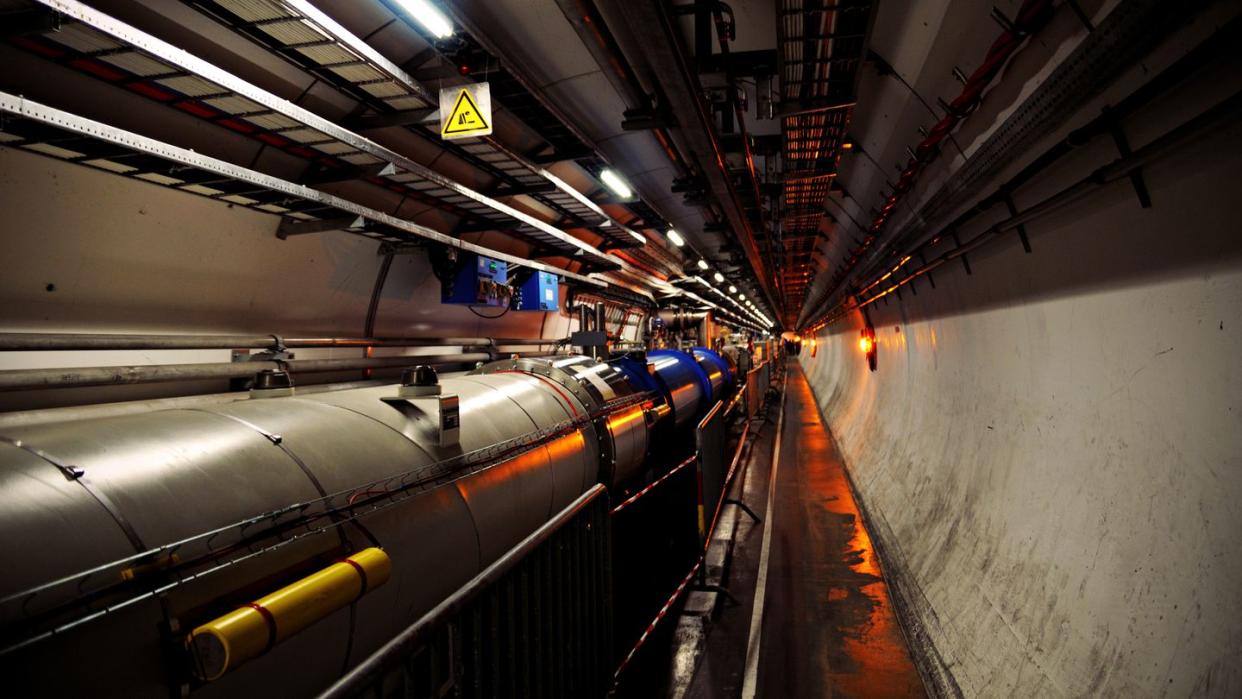This Is A Whole New Way To Look For Dark Matter

Researchers have proposed a whole new way to search for dark matter.
A team wants to use CERN’s Large Hadron Collider to look for what are called semi-visible jets”—columns of decaying particles that are made partially of “normal” particles, and partially of dark particles.
No one has found anything with this method yet, but CERN’s ATLAS Collaboration is excited by the results of initial experimentation and the potent for further investigation.
Dark matter is a substance that permeates our universe, interacting with “regular” matter and energy primarily through gravity. And that’s… about all we know. Now, we have plenty of theories about what this stuff might be, and we know it exists. But because we—by definition—can’t really interact with it, it remains one of the greatest scientific mysteries currently being investigated.
Researchers have thrown a lot of spaghetti at the proverbial wall looking for dark matter, and now, a team of experts lead by physicist Deepak Kar and postdoctoral researcher Sukanya Sinha have pioneered a whole new way of searching for it. According to their team’s new study—published in the journal Physics Letters B and based on Sinha’s PhD thesis, for which Kar was her advisor—we may be able to find evidence of dark matter mixed into Standard Model particles, the ones that make up everything we can see and touch.
Now, this isn’t going to be some kind of bang-zoom easy fix. It’s still dark matter after all—nothing is straightforward. For a start, the method requires the use of CERN’s Large Hadron Collider (LHC), the largest particle accelerator in the world. And the whole plan is based on theoretically being able to spot a hypothetical phenomenon called a “semi-visible jet.”
But if researchers can get past those two measly problems, the plan should work like a charm.
It’s a wild shift away from the ways we usually hunt for evidence of dark matter, but maybe a wild shift is what we need. It’s not like we’ve had much success with the standard methods. “There have been plethora of collider searches for Dark Matter over the past few decades [that] so far have focused on weakly interacting massive particles, termed WIMPs,” Kar said in a press release. “[WIMP] is one class of particles that are hypothesized to explain Dark Matter as they do not absorb or emit light and don’t interact strongly with other particles. However, as no evidence of WIMPs has been found so far, we realized that the search for Dark Matter needed a paradigm shift.”
“What we were wondering,” Kar continued, “was whether Dark Matter particles actually are produced inside a jet of standard model particles.”
Enter the idea of the semi-visible jet. When protons collide inside of a particle accelerator, they basically break up into other, even smaller particles like quarks and gluons, and then decay into “jets” of fundamental particles. In theory, those collisions could also produce the dark matter versions of quarks and gluons, which would then decay into semi-visible jets—jets where some of the energy is made of Standard Model particles and some of the energy is made of dark particles. Jets are produced in matching pairs, so if you produced a pair of jets in a collision and one of the jets was weaker than the other, the “missing” energy would be dark matter (as long as it wasn’t a technical flaw in the readings). We could measure dark matter by measuring the energy we didn’t detect.
Convoluted? Maybe. But radical ideas often are. This method would be probing into an entirely different regime of dark matter particles than almost every other collider-based dark matter experiment. Most of these experiments look for what are called WIMPs, or “Weakly Interacting Massive Particles” of dark matter. But the “semi-visible jet” route of study looks for strongly interacting dark matter particles, like dark quarks and dark gluons.
So far, the team hasn’t found any semi-visible jets, nor the particles that form them. But no one has found any WIMPs either, and experts have spent a whole lot more time looking for those.
Studying dark matter is still incredibly theoretical. But this particular avenue of study is exciting enough that CERN’s ATLAS Collaboration has designated this new paper one of its “flagship results,” and there will almost certainly be more experiments looking for semi-visible jets. “Even though my PhD thesis does not contain a discovery of Dark Matter,” Sinha said in the press release, “it sets the first and rather stringent upper bounds on this production mode, and already inspiring further studies.”
Now, we just wait to see what those studies turn up.
You Might Also Like


